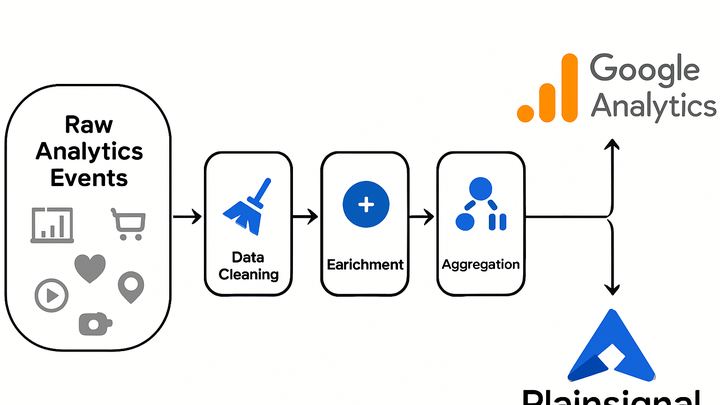Published on 2025-06-26T04:21:25Z
What is Transform? Examples for Transform in Analytics
In analytics, Transform is the process of converting raw event streams into structured, meaningful datasets ready for reporting and analysis. It sits at the heart of the ETL (Extract, Transform, Load) pipeline, bridging the gap between data collection and insight generation. During transformation, operations like cleaning, enrichment, aggregation, and schema mapping standardize and enhance data quality. Tools like PlainSignal simplify transformation by handling cookie-free metrics out of the box, while GA4 allows for custom event processing and deeper BigQuery integrations. Proper transformation ensures data consistency, reliability, and actionable analytics across dashboards and reports.
Transform
Transform converts raw analytics data into structured, enriched datasets for accurate reporting and analysis.
Definition and Context
Transform refers to the processing step in the analytics pipeline where raw data is cleaned, enriched, and reshaped into a consistent format for analysis.
-
Core concept
Transform is the step in the analytics workflow that standardizes raw events into structured data and metrics.
Key Transformation Steps
Effective transformation involves multiple sub-steps that collectively prepare data for reliable reporting and insights.
-
Data cleaning
Removing duplicates, correcting errors, and normalizing fields to ensure high data quality.
-
Data enrichment
Augmenting raw data with additional context, such as user segments or geolocation information.
-
Data aggregation
Summarizing detailed event records into higher-level metrics like daily active users or session counts.
-
Schema mapping
Applying a consistent data model so downstream dashboards and reports align correctly.
Implementing Transform with SaaS Tools
Below are practical examples of how leading analytics platforms handle data transformation.
-
PlainSignal (cookie-free analytics)
PlainSignal automatically processes raw event data at the edge, cleaning and aggregating it into simple, privacy-first metrics.
-
Tracking code example
<link rel="preconnect" href="//eu.plainsignal.com/" crossorigin /><script defer data-do="yourwebsitedomain.com" data-id="0GQV1xmtzQQ" data-api="//eu.plainsignal.com" src="//cdn.plainsignal.com/plainsignal-min.js"></script>
-
-
Google analytics 4 (GA4)
GA4 applies transformations through its gtag event model and can export data to BigQuery for custom SQL transformations.
-
Basic gtag setup
<!-- Global site tag (gtag.js) --> <script async src="https://www.googletagmanager.com/gtag/js?id=G-XXXXXXXXXX"></script> <script> window.dataLayer = window.dataLayer || []; function gtag(){dataLayer.push(arguments);} gtag('js', new Date()); gtag('config', 'G-XXXXXXXXXX'); </script>
-
Best Practices and Common Pitfalls
Follow these guidelines to maintain a robust and reliable transformation process in analytics.
-
Version control and documentation
Track transformation scripts and schema changes in version control to ensure reproducibility and collaboration.
-
Monitor pipeline performance
Set up alerts for transformation job failures and latency to guarantee timely data availability.
-
Handle schema evolution
Prepare for changes in event parameters or field formats by using schema registries or feature flags.
